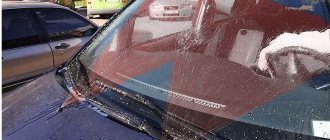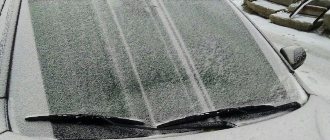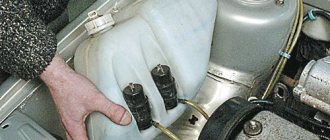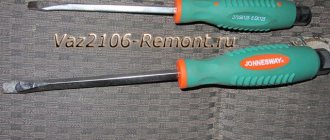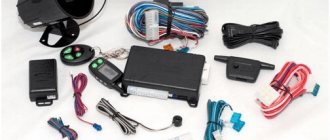Lada Vesta in the “Comfort” configuration is equipped with a windshield heating system. Other modifications do not have this benefit; drivers are forced to use a stove heater to defrost the glass.
Sequence of actions when activating the mode:
- Engage neutral gear.
- Insert the key, start the engine.
- After 1 – 2 minutes of idling, press the “Defrost MAX” windshield heating button.
- Wait until the ice on the glass thaws.
- If necessary, additionally activate the stove heater.
- When finished, deactivate the mode.
Control unit for ventilation and heating system with air conditioning (manual control)
- The air supply mode is regulated by pressing buttons numbered 11 – 16, the indicator light lights up.
- To cool the incoming air, press button No. 18.
- The minimum air temperature depends on the “degree” of the air outside, the angle of the sun’s rays, the fan rotation speed, the active recirculation mode, and the speed of movement.
- After turning on the air conditioner (separate button No. 18), the indicator light comes on. Cooled air enters the car interior, and the humidity decreases sharply.
Note to the driver!
Before activating the air conditioning system, be sure to start the car engine. Do not allow the “cooler” to operate when the outside air temperature is below 5°C.
- During operation of the air conditioner, moisture and condensation will accumulate under the bottom of the car on the asphalt. Don't worry, this is a natural process.
- Before starting the air conditioning system (hereinafter - AC), be sure to make sure that at least one or more deflectors on the dashboard are in the open position. Otherwise, the air ducts will freeze up and the air conditioner will fail.
- It is strictly forbidden to direct a flow of cold air onto the windshield or side windows. This will lead to freezing and fogging.
- Do not direct the air flow towards the body, limbs of the driver or passengers.
An active air conditioner takes 5–7% of power from the power unit, and also increases fuel consumption by 3–5%. The indicator values are averaged; the higher the speed, the greater the consumption. When driving in mountainous areas or serpentines, the SC can be deactivated automatically, as the load on the motor increases several times.
Related link:
Using the heated glass mode on the Lada Vesta.
How to use it correctly
Owners of Lada Vesta have already noticed the dependence of the heating operation on weather conditions and temperature conditions. The heating function is most effective when the air temperature is not higher than -10 degrees. When the snow flooring has slightly melted and moved, you can remove it using the wipers; hastily turning it on can lead to deformation of the brush drive mechanisms. At lower temperatures, it takes longer to warm up the glass. In this case, you should not expect an instant result from the function.
Air recirculation mode
Activation is carried out by button No. 19, the indicator light lights up. The air supply from outside is blocked, the climate control system takes the air flow inside the cabin.
The “Recirculation” mode is used to prevent smoke and exhaust gases from entering the cabin, as well as to accelerate the heating of the cabin during the first start after a long period of inactivity.
Note to the driver!
Do not overuse recirculation, as the lack of fresh air in the cabin causes drowsiness in the driver and passengers. Often this factor becomes the cause of accidents. To deactivate the mode, use the mechanical button (number No. 19). To start heating the rear and side windows, press button No. 15 once.
Testing heated side mirrors
The heated mirrors began to thaw first, this became noticeable within a minute:
After 3 minutes the ice melted almost completely, and after four minutes the mirror elements were completely dry:
At this moment, the air from the stove is already a little warm, the areas on the side windows near the mirrors and the bottom of the windshield begin to thaw. The rear window heating threads also became clearly visible.
The operating principle of the heated windshield Lada Vesta
After starting the engine, while it is idling, press the heater activation button once. The indicator begins to flash to confirm that the system is active.
The left and right halves of the windshield are heated alternately at intervals of 30 seconds. The duration of the entire cycle depends on a number of factors:
- temperature outside;
- machine downtime;
- technical condition of the unit;
- degree of clogging of deflectors and air ducts.
Dismantling
To connect, first of all, you need to gain access to the SAUKU - the heater and air conditioning control unit. On Vesta and X Ray, the algorithm is different, so it’s worth looking into everything in more detail.
Lada Vesta
In a sedan, the SAUKU unit is traditionally located on the center console. To get to it, you will need to remove 3 elements:
- Panel overlay (plastic);
- Key block;
- SAUKU overlay.
The plastic trim is fixed to the center console using plastic fasteners. To snap them off, you need to pry it at the bottom and pull it towards you.
Next, the panel with the keys is dismantled, which is attached to the clamps, also around the entire perimeter. They need to be snapped off.
The most difficult thing to remove is the SAUKU trim.
It is better to start working on the left side. First you need to get to the fuse box by removing the plastic cover that covers it. You need to turn the 3 plastic handles that secure the lid at the bottom, and then remove the lock from above.
In the end, all that remains is to pull the cover from below, disconnect the clamps that secure it to the device from above, and remove the cover. Once the fuse box cover is removed, you will need to remove 2 mounting screws.
Next, we move on to the central part, where it is also necessary to unscrew the 2 mounting screws, which are located directly under the panel with the keys.
Then all that remains is to unscrew 1 mounting screw on the right side, which is located under the glove box lid.
After this, access opens directly to the SAUKU block, which is attached to the cover plate with Torx screws. They need to be unscrewed and the plug disconnected.
Lada X Ray
Independent connection of a heated windshield on a Lada X-Ray through an additional alarm channel also begins with the removal of the SAUKU unit. Everything here is noticeably simpler than on Vesta. The panel itself with the block is fixed with 2 hooks at the top and 2 iron guides equipped with springs at the bottom.
You need to carefully pry the panel at the bottom and carefully pull it towards you. This will cause the top fasteners to disengage.
In the end, all that remains is to disconnect the plug from the wires.
Malfunctions of the heating control unit
If after 5 - 7 minutes of operation the glass heating does not work, then check the condition:
- fuses (number 38, 44);
- electrical wiring, in the area from the control unit to the generator, distributors;
- generator operation, measure the outgoing current.
In order to carry out a comprehensive diagnosis, seek help from service station specialists. For prevention on your own, use a device such as a multimeter.
Conclusion
In Lada Vesta Comfort, you can activate the glass heating at the touch of a button. In a few minutes, the surface of the glass will be cleared of ice and snow. Of course, in critical frosts, when the temperature drops below -17 – 18°C, the system is not as effective and requires more time to “warm up”. To speed up the process, additionally turn on the stove heater and shut off the air supply down the interior through the deflectors.
Related link:
Map updates in the CityGuide navigator on a Lada Vesta car
How to understand why the heated mirrors are not working and fix it yourself?
The option of heated mirrors is very helpful for drivers in winter. Without it, the surface of the mirror becomes covered with an ice crust, which significantly impairs visibility. But, like any other heating device, the heated mirrors sooner or later break down, which forces motorists to replace the mirrors with new ones. At the same time, they are quite expensive, and spending that kind of money is completely inappropriate, because you can restore them to working capacity on your own.
Necessary tool
The set of necessary tools is quite modest, and every motorist will probably have one. The first step is to get a multimeter to check the electrical circuit. We may also need a soldering iron, screwdrivers, electrical tape, and a spare fuse.
Let's start troubleshooting
The first step is to check the condition of the fuse responsible for heating the mirrors. To determine which fuse is responsible for the mirrors, you need to look at the repair instructions for your car on the Internet. If the fuse turns out to be blown, then simply replace it with a new one. You can determine that it has burned out not only visually, by looking at the broken wire inside, but also using a multimeter. To do this, you need to switch it to the resistance measurement mode and touch the fuse contacts with the probes; if the device does not show anything, then the fuse has burned out.
Checking the button
If the fuse turns out to be working, then you should next check the heating button. Sometimes it happens that the contacts on it burn out and it stops working. Checking its functionality is quite simple, but getting to the wires we need can be difficult. To gain access to the reins that fit the button, you need to remove the panel on which it is located. Next, we again take the tester with the resistance testing mode turned on and press the probes to the button contacts. When you press the button, a short circuit should occur, that is, some numbers will appear on the device. If nothing happens, then the problem is in the button, and it needs to be replaced with a new one.
Looking further
The next stage of the search is disassembling the mirror. It must be removed from the car, and the wires that go to it must be checked for voltage. To do this, switch the tester to voltmeter mode, press the heating button and, applying one probe to a metal part on the body, and the second to a wire contact, measure the voltage. It should be 12-14 V. If there is current, then everything is in order with the wiring, and we only have one suspect left - the heating element.
Calling the mirror
It is necessary to determine whether there is a break in the filament that is glued to the mirror. We take the tester, turn on the resistance test mode and touch the mirror contacts with the probes. The resistance of a working mirror should be in the region of 10 to 30 ohms. If the device shows 100 ohms or more or even a break, then the fault has finally been found. Some heating elements cannot be repaired and must be replaced. But there are mirror designs from which you can peel off the old heating element and install a new one in its place.
You can buy a new heating plate at automotive stores. Some of them are sold without terminals for the wires, and this is where we need a prepared soldering iron. You will need to unsolder the male terminals from the old mirror and solder them into the new heater. Next, we glue the new plate onto the mirror and, after checking its functionality, put everything back together.
Photos from Internet resources
Reviews
| № | Positive |
| 1. | Stepan , 44 years old (www.otzovik.com): the heating system (hereinafter referred to as the heating system) in the Lada Vesta is functional; it takes no more than 5 minutes to completely clean the glass. |
| 2. | Fedor , 40 years old (www.zr.ru): in severe frosts, heating elements take longer to heat up, on average 7 – 10 minutes. If the temperature outside is below -15°C, a few minutes are enough. |
| 3. | Vladimir , 22 years old (www.autobann.su): I’m happy with the car, its functionality, no comments. |
| 4. | Sergey , 33 years old (www.lada-vesta.net): the “Defrost MAX” system works well in cold weather, no comments. |
| 5. | Semyon , 43 years old (www.otzovik.com): after 3 - 4 minutes after starting the CO, the glass heats up and the ice melts. |
| 6. | Svyatoslav , 44 years old (www.zr.ru): the car is two years old, the CO works stably, without any problems. |
| 7. | Mikhailovich , 20 years old (www.autobann.su): in winter the CO worked at 100, the windows warmed up in a matter of seconds. |
| 8. | Anatoly , 43 years old (www.lada-vesta.net): my positive review of the “Defrost MAX” system. In twenty-degree frosts I had no problems with warming up. |
| 9. | Gennadievich , 39 years old (www.otzovik.com): the car is two years old, the systems are working normally, without any problems. |
| 10. | Dmitrievich , 43 years old (www.zr.ru): I recommend the Lada Vesta in the maximum configuration, a decent domestic car, good quality, affordable price. |
| 11. | Konstantin , 35 years old (www.autobann.su): the heating system is good, I don’t use it often. |
| Negative | |
| 12. | Victor , 44 years old (www.zr.ru): CO does not help in severe frosts, insufficient heating, icing in places. |
| 13. | Alexey , 37 years old (www.otzovik.com): the system worked for six months, after which the heating element burned out, took it to a service station for replacement under warranty. |
| 14. | Stepan Ignatievich , 46 years old (www.autobann.su): the implementation of CO in Renault Logan, Megan of the second generation is better organized. |
Connection
Not all 2180 owners are satisfied with the operation of heating the windshield, rear windows and rear-view mirrors simultaneously with the heater fan and air conditioning. There is one way out of this situation - installing a separate button. Even on Vesta models that do not have a heated windshield function as standard, it is possible to connect this very convenient function when replacing the glass unit. If you need to replace your heated windshield for technical reasons, you should contact an official Lada dealer. Under the guarantee, the procedure is carried out free of charge, after an examination. It is necessary to make sure that replacing the windshield with heating is the only solution to the problem, since not a single part will last better than the original one. Careful operation and compliance with the recommendations of specialists will significantly extend the service life of the heating device. High water pressure on the windshield should be avoided when visiting car washes. Timely replacement of wiper blades is necessary, because poor-quality wipers scratch the glass surface.
Which Vesta configurations include heated car glass?
Unfortunately, in the basic configuration of the Lada Vesta, you are unlikely to find such an option as a heated windshield. The minimum configuration that includes heating is Comfort. The cost of Vesta with a set of Comfort options is at least 592,000 rubles (at the end of March 2022). If you compare it with the base, the difference in price is a little more than 75,000 rubles.
If you fundamentally need this option, but there is no way to overpay almost a hundred thousand rubles, then you can install a heated windshield on your car in the future - it will cost much less, especially if you do this work yourself.
In Luxe trim levels you will receive the “Defrost MAX” button, which was already mentioned above. This button comprehensively launches all possible systems to speed up the heating of all windows and side mirrors of the car.
Good afternoon everyone. In the summer there was no need to heat the side mirrors and rear window. With the arrival of autumn, the need for heating appeared, and this is what happens: when you turn on this wonderful function on a cold engine after pressing the gas pedal, the engine speed rises as expected, but either does not fall back at all or falls but with a very large delay (10 seconds) . On a warm engine, too, everything does not work as we would like: for example, at the moment of changing gear, removing your foot from the gas pedal, there is a sharp increase in revolutions by about 500-1000, and only then the revolutions drop, and the average fuel consumption if you believe the on-board computer when turned on this function increases by 0.8 liters. Has anyone encountered this? Is this normal or should I urgently go to the authorities?
In winter, my revs generally went to maximum. I thought the engine would explode)) This happened three times, then it seemed to return to normal. Now I’m even afraid to set autostart...
Dismantling
To connect, first of all, you need to gain access to the SAUKU - the heater and air conditioning control unit. On Vesta and X Ray, the algorithm is different, so it’s worth looking into everything in more detail.
Lada Vesta
In a sedan, the SAUKU unit is traditionally located on the center console. To get to it, you will need to remove 3 elements:
- Panel overlay (plastic);
- Key block;
- SAUKU overlay.
The plastic trim is fixed to the center console using plastic fasteners. To snap them off, you need to pry it at the bottom and pull it towards you.
Next, the panel with the keys is dismantled, which is attached to the clamps, also around the entire perimeter. They need to be snapped off.
The most difficult thing to remove is the SAUKU trim.
It is better to start working on the left side. First you need to get to the fuse box by removing the plastic cover that covers it. You need to turn the 3 plastic handles that secure the lid at the bottom, and then remove the lock from above.
In the end, all that remains is to pull the cover from below, disconnect the clamps that secure it to the device from above, and remove the cover. Once the fuse box cover is removed, you will need to remove 2 mounting screws.
Next, we move on to the central part, where it is also necessary to unscrew the 2 mounting screws, which are located directly under the panel with the keys.
Then all that remains is to unscrew 1 mounting screw on the right side, which is located under the glove box lid.
After this, access opens directly to the SAUKU block, which is attached to the cover plate with Torx screws. They need to be unscrewed and the plug disconnected.
Lada X Ray
Independent connection of a heated windshield on a Lada X-Ray through an additional alarm channel also begins with the removal of the SAUKU unit. Everything here is noticeably simpler than on Vesta. The panel itself with the block is fixed with 2 hooks at the top and 2 iron guides equipped with springs at the bottom.
You need to carefully pry the panel at the bottom and carefully pull it towards you. This will cause the top fasteners to disengage.
In the end, all that remains is to disconnect the plug from the wires.
Necessary tool
To ensure that the replacement of the VAZ 2110 windshield goes smoothly, you should get a gluing kit. When purchased through an online store, the TEROSON PU kit will cost about 1,150 rubles, but will quickly recoup the costs. Its composition:
- instructions for use.
- applicator;
- cloth for cleaning surfaces;
- 8596 sealing adhesive;
- cartridge nozzle;
- primer;
- cutting wire;
In addition, you need to have other devices on hand:
- new consumable.
- several office knives;
- solvent for nitro paint;
- a set of flat screwdrivers and spatulas;
With an assistant, changing parts is easier and faster.
Price is not a guarantee of quality! But you shouldn’t take the cheapest materials either - fakes are not uncommon.
Do-it-yourself modification
Attention! You perform all actions at your own peril and risk. The author is not responsible.
You will need: install an additional non-locking button in the car panel (or buy a block with five buttons), a relay with two groups of switching contacts, 1N4007 diodes and a transistor.
Description of the circuit: When the button is pressed, the low level at pin S1-14 activates the standard heating of the entire CBKE and at the same time the relay is activated due to the pickup by the transistor for a time determined by the capacitance of the capacitor. After 3-4 seconds, a low level appears at pin S1-34 and fixes the relay in the on state for the time specified in the CBKE (6 minutes). The relay turns off the heated mirrors and rear window, leaving only the windshield.
As a result, when you press the additional button, the indicator of the standard button lights up and only the heated windshield turns on. After 6 minutes it turns off on its own.
screensaver
Vesta was not deprived of options. Having given money for them, naturally, you want them all to work and fulfill their functions. There were a couple of “saboteurs” on our car.
All Vestas have automatic door locking when starting to move, but ours refused to lock the doors when the speed reached 7 km/h from the very beginning. The instructions are silent about the fact that this function can be disabled, but experience with foreign cars suggests that there are usually “on” and “off” modes. And so it turned out: after holding the key on the front panel for several seconds, the auto-lock turned on, although only for five to ten cycles, after which it had to be activated again.
Types of damage
The windshield is made of triplex, an impact-resistant material that has two layers of glass and a thin film in the middle. This prevents the parts from falling apart upon impact.
Masters divide damage into two types:
- Fries. Only the top layer was damaged. No immediate replacement is required.
- Cracks. In this case, deliver new material as quickly as possible. The film holds the debris, but not as firmly as before, and with a hole, which is not uncommon on our roads, they will separate. This will lead to an accident.
If you can’t change it in the near future, you can resort to some tricks:
- Make perpendicular cuts along the edges of the “web”.
- Drill 5mm holes along the edges of the slot.
- “Brew” the damage.
All measures will have a temporary effect and the spare part will still have to be replaced.
Advice from professionals
- For information on how to properly and effectively repair a windshield, read our article “A crack in the windshield, how to fix a crack with your own hands.”
- Never attempt to replace or install heated glass unless you have sufficient experience and knowledge.
- As an alternative to a heated windshield, there is a portable heated windshield that operates directly from the cigarette lighter, and a special washer fluid reservoir heater.
- A heated windshield allows you to cope well with the problem of icing, without the need to stir the windshield with all kinds of brushes and scrapers. Which often cause many small scratches.
- Despite all the advantages of heating the windshield. Heat often causes cracks in the windshield.
Peculiarity
Owners of the sedan and crossover noticed one technological feature - the heated windshield of the Lada Vesta and X-Ray cannot be turned on remotely, even if the engine has automatic start. Because of this, many people, after starting the engine remotely, even when the power unit warms up, have to wait until the windshield thaws.
On models equipped with climate control, this problem is almost non-existent, since the climate control unit, after the engine is turned off, remembers the functions that were turned on before and, upon subsequent startup, activates them too. Therefore, in order not to wait for the glass to thaw, you just need to remember to turn on the heating, and at the same time the mirrors, before turning off the engine.
Results
In severe frost (at -20 degrees), the thawing order will be approximately as follows:
- 1 minute - the ice on the mirrors begins to melt;
- 2.5 minutes - the ice on the mirrors has almost melted, the bottom of the windshield (stove) begins to thaw;
- 4 minutes - the mirror elements are completely dry, the snow on the threads of the rear window will melt;
- 5-6 minutes - the windshield and areas on the side windows near the mirrors noticeably move away from the ice;
- 7-8 minutes - the heating has melted the ice from the main part of all the windows, you can drive.
In warmer weather, you can start driving earlier, as soon as the engine speed drops to operating speed. There are no comments on the operation of Vesta’s heating; one can only find fault with the fact that the seat heating is not adjustable.
Let us remind you that a discussion of the reasons why Vesta does not start well in cold weather or why the engine does not start at all is not included in this article. Other reviews and tests are in this category. Leave feedback on the operation of the heaters in the comments to the article.
Often on forums, in VK groups, etc. I see complaints from owners that glass heating does not work well. Many people say that the windshield heating does not work at all. Interesting, I thought. Everything is fine with me.
Posted the video on YouTube. And so it began... All the commentators, owners and those who were not even close to Vesta, as well as various “experts” in heating, began to assure me that everything was wrong, it was not true, the engine was warm and that sort of thing. There were many opinions that it was just warm, and at -10°C and below, the windshield heating does not work “a hundred pounds”.
Some believed. Some doubted that it was -20. Although the snow creaked a lot and I filmed it (who doesn’t know - the lower the temperature, the better you can hear the creaking of the snow). And the regular BC showed -19. But then, as the engine warmed up, it began to lie, as usual. You should have placed your street thermometer next to the car. But I didn’t want to tear the windows off the plastic. Well, okay, the weather forecast for the Belgorod region will help them. Some said that everything was nonsense, although then I still didn’t understand lying to me. Some have become convinced that heating is not needed for nothing. To be fair, it is worth noting that there are people who agreed - yes, windshield heating is a good thing. Here I am attaching both videos. They are long - because of distrust, I didn’t cut anything out. If you are interested in this question, take a look. Tell us in the comments if this option is useful and how it works for you.
3_4
The photo shows the glass after 8 minutes of heating at an outside temperature of -13 degrees. The rear one has become transparent, but on the windshield there is only a narrow embrasure from the heater fan blowing. If you wave the wipers, they will not cause any damage to the ice on the glass. The photo shows the glass after 8 minutes of heating at an outside temperature of -13 degrees. The rear one has become transparent, but on the windshield there is only a narrow embrasure from the heater fan blowing. If you wave the wipers, they will not cause any damage to the ice on the glass.
The photo shows the glass after 8 minutes of heating at an outside temperature of -13 degrees. The rear one has become transparent, but on the windshield there is only a narrow embrasure from the heater fan blowing. If you wave the wipers, they will not cause any damage to the ice on the glass.
However, electronic diagnostics revealed some errors, and they were erased from memory. So far the frosts have receded, so I can’t say anything about changes in the heating operation yet. Taking this opportunity, I would like to ask the owners of Russian cars and foreign cars with a warm windshield: how efficiently does it heat up in yours?
Lada Vesta from ZR park: going for service
Flaws
Let us dwell on the negative aspects of the heating function:
- expensive replacement in case of breakdown. The slightest impact on the glass, for example, a pebble from under a wheel, leads to the appearance of cracks and huge cracks. Repairs can cost up to 100,000 rubles depending on the make of the car.
- temperature changes can lead to destruction of the glass surface (especially if the ambient temperature is -30 degrees). But it is worth saying that special relays are now used to solve this problem;
- the presence of thin threads forming a mesh interferes with the operation of radar detectors and other gadgets;
- high price for installing such an option (especially on German cars);



